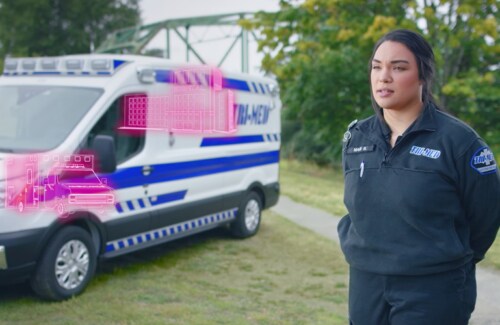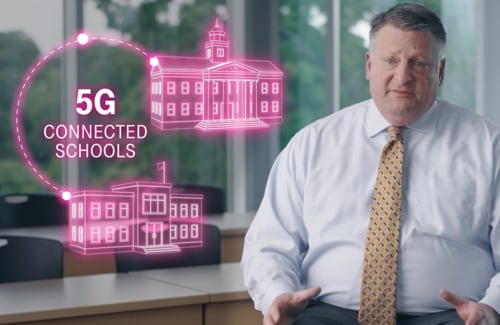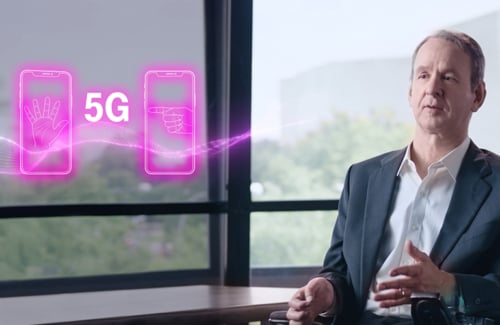5G will unleash a massive new round of innovation, and the New T-Mobile is poised to deliver a truly transformative 5G network across the country, should regulators approve T-Mobile’s merger with Sprint. With the combined assets of the two companies, along with a significant investment in building out a new supercharged 5G network, the New T-Mobile will be able to quickly develop and deploy 5G for all. 5G will usher in a wave of change and innovation, bolstering the economy and helping bridge the digital divide. The impact will be far-reaching.
To get a better sense of that impact, we’ve sought out experts in their respective fields to share their own vision of how 5G for all will empower people across this diverse country.
Today, we hear from Mariana Beckham, an experienced Emergency Medical Technician (EMT) with Tri-Med Ambulance, a private ambulance company that has been serving the greater Seattle area since 1995. Starting out with just a trio of ambulances, Tri-Med now runs an impressive fleet of 35 state-of-the-art ambulances that are exclusively contracted with multiple Fire Departments throughout Puget Sound — and depended upon at the most crucial of times.
“5G stands to revolutionize emergency medical care,” says Beckham, “saving critical time, and, in turn, helping first responders save lives.”
Beckham offers key insights as to how 5G will revolutionize emergency response for Tri-Med and EMTs everywhere.
What will 5G mean for an ambulance responding to an emergency situation?
In a life-or-death emergency situation, every split-second counts. With 5G, pretty much everything can be connected, including ambulances. Imagine if, instead of just using lights and sirens, a connected ambulance could push out alerts to individual vehicles that it’s approaching, even before a driver can see or hear it, and even communicate to streetlights, crosswalks and the roads. Other vehicles will make way sooner, improving safety and response times. 5G could very literally help clear the pathway to a whole new approach to emergency response. This will be crucial in helping an ambulance get to its destination as quickly and safely as possible. It will significantly impact our overall patient care. 5G will help us save time, which in turn will help us save lives.
How will 5G transform patient care?
Delivering information to a hospital is one of the most important aspects of our job. With 5G connectivity, first responders and their vehicles will be highly connected to hospitals and other emergency facilities. It will also offer an EMT or paramedic the ability to conduct high-definition ultra-sounds or X-Rays and transmit that data, and have a real-time conversation with a physician or clinician, so even more triage could happen in ambulances — well in advance of arriving at the hospital. Additionally, the information will aid decisions on which hospital the patient should be taken to, and the on-site doctors and staff will be prepared for when the patient arrives. 5G will effectively turn our emergency vehicles into emergency rooms.
Can you tell us a bit more about how a 5G-connected ambulance might look?
For one, augmented reality will definitely make a huge difference in our first responder situations. Connected glasses could display critical information for an EMT. The patient’s medical history and medications, their allergies, age, blood pressure, heartrate, oxygen levels — augmented reality will be a breakthrough tool in setting up first responders with that life-saving data.
5G-connected monitors will be able to call for help. Some patients with a severe medical condition will have embedded or wearable monitors, capable of informing first responders and doctors of their condition and history. So let’s say someone with a heart condition collapses. Her monitor would detect the fall and immediately alert emergency dispatch. An ambulance specifically equipped and staffed with first responders trained for heart attacks and cardiac arrest would be sent to her location. They would have life-saving medication — specifically prescribed to that patient — ready to administer the moment they arrive.
What other sorts of life-saving breakthroughs will 5G usher in for emergency response?
I think in the near future, 5G-connected drones will play a critical role in emergency response. With 5G there won’t be any lag time with what the drone sees to what the drone operator sees. We’ll be able to safely fly life-saving equipment or medications beyond line-of-sight, directly reaching a patient, wherever they are. For example, an AED (portable defibrillator) for someone having a heart attack or an EpiPen for someone who is having a severe allergic reaction. Imagine if we were able to help a hiker who is stranded where we just can’t get an ambulance to them. With 5G-connected drones, we’d be able to locate and survey disaster areas, locate victims and provide water and other crucial supplies that are necessary for survival. In a life-and-death situation, just a few seconds changes everything. 5G will expand the horizons of what’s possible today and help first responders of tomorrow set new ones — and very literally soar beyond them.
Important Additional Information
In connection with the proposed transaction, T-Mobile US, Inc. (“T-Mobile”) has filed a registration statement on Form S-4 (File No. 333-226435),which was declared effective by the U.S. Securities and Exchange Commission (the “SEC”) on October 29, 2018, and which contains a joint consent solicitation statement of T-Mobile and Sprint Corporation (“Sprint”), that also constitutes a prospectus of T-Mobile (the “joint consent solicitation statement/prospectus”), and each party will file other documents regarding the proposed transaction with the SEC. INVESTORS AND SECURITY HOLDERS ARE URGED TO READ THE JOINT CONSENT SOLICITATION STATEMENT/PROSPECTUS AND OTHER RELEVANT DOCUMENTS FILED WITH THE SEC WHEN THEY BECOME AVAILABLE BECAUSE THEY WILL CONTAIN IMPORTANT INFORMATION. The documents filed by T-Mobile may be obtained free of charge at T-Mobile’s website, at www.t-mobile.com, or at the SEC’s website, at www.sec.gov, or from T-Mobile by requesting them by mail at T-Mobile US, Inc., Investor Relations, 1 Park Avenue, 14th Floor, New York, NY 10016, or by telephone at 212-358-3210. The documents filed by Sprint may be obtained free of charge at Sprint’s website, at www.sprint.com, or at the SEC’s website, at www.sec.gov, or from Sprint by requesting them by mail at Sprint Corporation, Shareholder Relations, 6200 Sprint Parkway, Mailstop KSOPHF0302-3B679, Overland Park, Kansas 66251, or by telephone at 913-794-1091.
No Offer or Solicitation
This communication shall not constitute an offer to sell or the solicitation of an offer to buy any securities, nor shall there be any sale of securities in any jurisdiction in which such offer, solicitation or sale would be unlawful prior to registration or qualification under the securities laws of any such jurisdiction. No offering of securities shall be made except by means of a prospectus meeting the requirements of Section 10 of the U.S. Securities Act of 1933, as amended.
Cautionary Statement Regarding Forward-Looking Statements
This communication contains certain forward-looking statements concerning T-Mobile, Sprint and the proposed transaction between T-Mobile and Sprint. All statements other than statements of fact, including information concerning future results, are forward-looking statements. These forward-looking statements are generally identified by the words “anticipate,” “believe,” “estimate,” “expect,” “intend,” “may,” “could” or similar expressions. Such forward-looking statements include, but are not limited to, statements about the benefits of the proposed transaction, including anticipated future financial and operating results, synergies, accretion and growth rates, T-Mobile’s, Sprint’s and the combined company’s plans, objectives, expectations and intentions, and the expected timing of completion of the proposed transaction. There are several factors which could cause actual plans and results to differ materially from those expressed or implied in forward-looking statements. Such factors include, but are not limited to, the failure to obtain, or delays in obtaining, required regulatory approvals, and the risk that such approvals may result in the imposition of conditions that could adversely affect the combined company or the expected benefits of the proposed transaction, or the failure to satisfy any of the other conditions to the proposed transaction on a timely basis or at all; the occurrence of events that may give rise to a right of one or both of the parties to terminate the business combination agreement; adverse effects on the market price of T-Mobile’s or Sprint’s common stock and on T-Mobile’s or Sprint’s operating results because of a failure to complete the proposed transaction in the anticipated timeframe or at all; inability to obtain the financing contemplated to be obtained in connection with the proposed transaction on the expected terms or timing or at all; the ability of T-Mobile, Sprint and the combined company to make payments on debt or to repay existing or future indebtedness when due or to comply with the covenants contained therein; adverse changes in the ratings of T-Mobile’s or Sprint’s debt securities or adverse conditions in the credit markets; negative effects of the announcement, pendency or consummation of the transaction on the market price of T-Mobile’s or Sprint’s common stock and on T-Mobile’s or Sprint’s operating results, including as a result of changes in key customer, supplier, employee or other business relationships; significant transaction costs, including financing costs, and unknown liabilities; failure to realize the expected benefits and synergies of the proposed transaction in the expected timeframes or at all; costs or difficulties related to the integration of Sprint’s network and operations into T-Mobile; the risk of litigation or regulatory actions, including the antitrust litigation brought by the attorneys general of certain states and the District of Columbia; the inability of T-Mobile, Sprint or the combined company to retain and hire key personnel; the risk that certain contractual restrictions contained in the business combination agreement during the pendency of the proposed transaction could adversely affect T-Mobile’s or Sprint’s ability to pursue business opportunities or strategic transactions; effects of changes in the regulatory environment in which T-Mobile and Sprint operate; changes in global, political, economic, business, competitive and market conditions; changes in tax and other laws and regulations; and other risks and uncertainties detailed in the Form S-4, as well as in T-Mobile’s Annual Report on Form 10-K for the fiscal year ended December 31, 2018 and in its subsequent reports on Form 10-Q, including in the sections thereof captioned “Risk Factors” and “Cautionary Statement Regarding Forward-Looking Statements,” as well as in its subsequent reports on Form 8-K, all of which are filed with the SEC and available at www.sec.gov and www.t-mobile.com. Forward-looking statements are based on current expectations and assumptions, which are subject to risks and uncertainties that may cause actual results to differ materially from those expressed in or implied by such forward-looking statements. Given these risks and uncertainties, persons reading this communication are cautioned not to place undue reliance on such forward-looking statements. T-Mobile assumes no obligation to update or revise the information contained in this communication (whether as a result of new information, future events or otherwise), except as required by applicable law.





